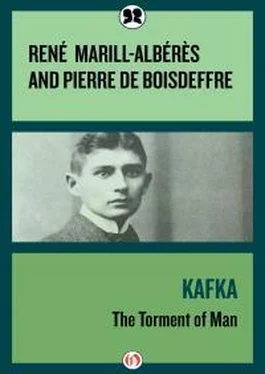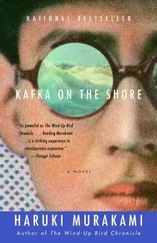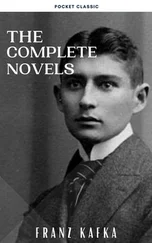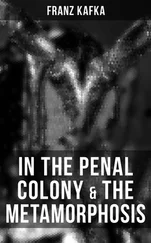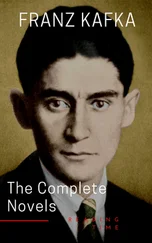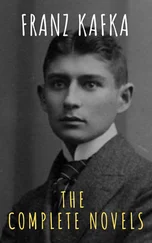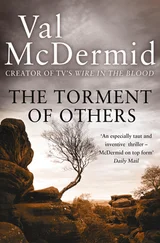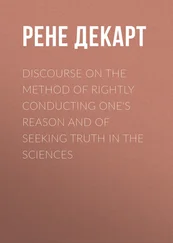To express common, universal anguish, Kafka always chooses a narrow, definite, limited character—a country doctor, a miner, a bureaucrat, a trapeze artist. The individual is always eccentric. In “First Sorrow” the trapeze artist cannot live unless he is always perched on his trapeze. In “The Giant Mole” the village schoolmaster has but one aim in life—to demonstrate in his scholarly memoirs the existence of a giant mole which he has never seen.
Thus human solitude is the first fact associated with man. It also happens that the dreadful singularity that imprisons man in a mania and separates him from the world is experienced by a living individual as an ineluctable condition of his being, an external curse, obligation, or decree of fate. In this case, with a troubled human conscience, he is forced to adjust to a body and destiny that limit him. As Gregor Samsa became a multiped, the hero of “The Bridge” is—a bridge.
I was stiff and cold, I was a bridge, I spanned an abyss. My toes sank into the ground on one side, my hands clutched the earth on the other side.… I was there, then, and I waited; and I was obliged to wait. Without crumbling, a bridge, once it has been built, cannot cease to be a bridge.
Let us enumerate the heroes of Kafka’s tales: a man who was transformed into a multiped, a professional hunger artist, a commercial traveler, a mole, the ghost of a hunter (“The Hunter Gracchus”). Each of them has a conscience—its activity guides the narrative—but it is imprisoned in a grotesque body which transforms it into an eccentric conscience. Let us add to these a mouse (“Josephine the Singer, or the Mouse Folk”), a dog (“Investigations of a Dog”), a monkey changed into a man (“A Report to an Academy”). This is the explanation of the theme of animal metamorphosis. In sketches that have the obsessive, precise form of memoirs, Kafka always begins anew (and rarely finishes) with a “trapped” conscience. This entrapment is especially obvious when, in keeping with Gnostic beliefs, the soul has fallen into the body of an animal. “The Metamorphosis” is simply the first form of this obsession. For we find in “The Burrow” the repetitive moralizations of an animal; in “Investigations of a Dog,” the tiresome repetitions of a limited, patient, pedantic, complicated creature proud of his condition even though he senses that he is a prisoner.
It must be assumed that, for all my peculiarities, which I readily acknowledge, I am the least exempt from the laws of my species. Indeed, when I think about it—and I have time, disposition, and capacity enough for that—the canine world is strange. Around us dogs there are all kinds of creatures—wretched, limited, dumb creatures who have only animal cries; … many of us dogs study them, have given them names, try to help them, educate them, uplift them, etc. For my part, so long as they do not try to disturb me, I make no distinction between them, I ignore them.
Here we undoubtedly rediscover the inspiration of Hofmann’s tale “Murr the Cat.”
Dogs know everything, they have all the questions and all the answers. If only this knowledge could be put to use, brought fully to light; if only they did not know infinitely more than they acknowledge or admit to themselves.
But the humor is the same in “Josephine the Singer,” a sociological study of the success of a singer; only at the end of the story do we discover that it concerns mice and the success of a mouse that could sing. And in a short tale recorded in the Notebooks , a family gathers around a dead relative; conscientiously they devour the corpse; the characters are all rats. Kafka is obsessed by animality, the symbol of a creature falsified by its slough. This accounts for the great number of cockroaches and skunks in his works.
Perhaps Kafka was remotely inspired by the satire which his friend Franz Blei wrote ( The Great Literary Bestiary ) depicting men of letters under the guise of animals. But Franz Blei was not tormented, and there is something else in Kafka: cultivation of delight in moderate or severe eccentricity which expresses the dreadful loneliness and astounding singularity of creatures enclosed in their own skins. “I have a strange beast,” he writes, “half kitten, half lamb. I inherited it from my father. But it did not develop until I came into possession of it; before that, it was more lamb than cat. Now it is half one and half the other.”
“Metamorphosis” or terror of falling into animality is traceable to an unconsciously Gnostic idea which might well have been transmitted to Kafka by way of the Cabala. Gnosticism—which incorporates Manicheism and which inspired a parallel Jewish tradition—reduces the destiny of created spirits to an upward or downward movement on the scale of living beings. A popularizer of these doctrines, Victor Hugo explained them in Words of the Voice of Darkness . Man may die at any moment and, depending on his past merits, be reborn as an angel, a weasel, a cockroach or a pebble. The soul is imprisoned at various depths in matter, from which it tries to free itself as it moves upward by degrees. By depicting the plight of animals and their fallen consciences, Kafka expresses the terror of being obliged to move like a bottle imp through all degrees of salvation and the abyss. And he reveals himself, involuntarily but clearly, as a Gnostic and Manichean when he states that Evil is the Fall in a form of incarnation that becomes progressively darker . “There is nothing except a spiritual world; what we call the sensible world is Evil in the spiritual world and what we call Evil is merely a momentary necessity in our eternal evolution.” 11This is precisely the Gnostic and Cabalistic vision which Hugo, for example, had popularized.
A creature is a prisoner of its form of incarnation, and if it takes delight in this form, it is condemned to descend still further. But if fallen beings shut themselves up, they also feel—and quite obviously—that the world is closed to them.
“Alas,” said the mouse, “the world becomes narrower each day. It was once so big that I was afraid. I ran, and I ran, and I was happy to see finally, on all sides, walls rising into view on the horizon; but these long walls run together so quickly that I am already in the last room, and I see down there the trap into which I am going to fall.”
“You need only change direction,” said the cat as he devoured the mouse. 12
Is this not already the whole problem of The Trial? Kafka’s numerous stories are apologues. In some, conscience is a prison; in others which complement them, the world is a labyrinth, ridiculous perhaps, but inexorable.
I had fallen into an inextricable bush. I shouted as loudly as I could for the keeper of the park. He came running, but he could not reach me.
“How did you manage to get yourself in there?” he shouted. “Get yourself out the same way!”
“Impossible,” I answered, “there is no way. I was walking along calmly, lost in thought, and suddenly here I am! As if the bush had grown up around me. I’ll never get out, I’m lost!”
“Child,” said the keeper. “You begin by taking a forbidden road, you get into this terrible bush, and you complain … But you are not in a virgin forest! This is a public park. You will be set free.” 13
But he was not set free.…
In some stories Kafka evokes the “burrow,” a small closed universe, frightfully logical and circumscribed. If the animal leaves this lair, he discovers an unlimited but absurd world.
Between the lonely creature sweltering in his heat (“The Burrow,” “Investigations of a Dog”) and God who can satisfy him, there is a meeting ground—life. But life refuses to provide the occasion for the meeting. When in order to live a creature ventures forth on his lands, he finds only a new labyrinth. Life should guide man to his ultimate end—that is, to God—but it causes him to become lost in its passageways, in a tunnel.
Читать дальше
